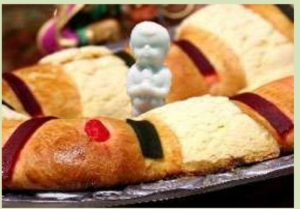By Terry Sovil from the December 2010 Edition
The Beach Boys sang “Christmas Comes This Time Each Year”. Listen for it the next time you’re in Wal-Mart.
Día de Muertos (Day of the Dead) festivities are over. Mid-November the stores are pulling out all stops. Christmas trees, ornaments and foods are appearing. Are there Mexican Christmas traditions? Well, Virginia, is there a Santa Claus? There are many Mexican traditions! Let’s mention a few and see if we can all get in the mood.
Posadas
Posadas run the nine days before Christmas, the 16th to the 24th. This is a re-enactment of Mary and Joseph seeking shelter in Bethlehem. The group, the Santos Peregrinos (Holy Pilgrims) goes to two designated homes seeking a place to stay. They are turned away but at the third are told there is no room inside but they may stay in the stable. They are given entrance and the posada – a fiesta – is held. This occurs each afternoon headed by a young child acting as Mary, Virgen María, often on a live burro. Others may follow portraying angels, the Three Kings or a host of pastores y pastoras (shepherds and shepherdesses).
Nacimientos (Nativity Scenes)
Christmas Trees are gaining in popularity but for now the Nativity scenes are more common. There are public displays presented in yards and some folk art nativity scenes. Usually set up on December 16, the baby Jesus is put in place on December 24th. The three kings are added January 5th. Usually made of clay or plaster the central point is a stable where the family is sheltered. There are also shepherds, sheep and oxen. Some are very elaborate and occupy an entire room. You may spot a progressive Nativity scene with a Christmas tree.
Nochebuena (Christmas Eve)
The last posada is held on this day. Many attend a midnight mass (Misa de Gallo or Rooster’s Mass) then have traditional dinners with families. The fare is often simple homemade tamales or regional dishes but can include roast turkey, ham or suckling pig for those that can afford it. A hot fruit punch (ponche) is served or a sparkling cider (sidra) for the holiday toast (brindis). Gifts are not usually given but are becoming more common. Since these parties go late into the night Christmas Day is usually quiet with leftovers (el recalentado). With no Santa Claus, Christmas wishes go to the el Niño Dios (the Holy Child) for Christmas Eve and the Reyes Magos (Magi) for Three Kings Day.

Poinsettias: La Flor de Noche Buena
The Flor de Noche Buena (Christmas Eve Flower) is grown in Mexico. It has become a common flower for Christmas in many parts of the world. Who doesn’t like beautiful mid-winter flowers? The petals are not really the flowers but simply colorful leaves that surround the true blossom, a cluster of yellow florets. The petals come in a variety of colors. For non-gardeners there is a form of Noche Buena which is a rich, dark, bock-like beer found only during the holidays!

Los Santos Inocentes (Holy Innocents)
Celebrated December 28th, this is a reminder of King Herod’s order to kill all male infants intended to include the Christ Child. In Mexico, this day is similar to April Fool’s day. Watch out for potential jokes and pranks or you may be the “Fool Saint” for the day.
Año Nuevo (New Year)
New Year’s Eve is a late-night dinner with families. Those who want to party go out afterwards. There may be fireworks over the bay so keep an eye out for the display.
Dia de Reyes (The Three Kings: Los Reyes Magos)
January 6 is Día de Reyes or “Kings Day”. Gifts are exchanged much as the three wise men brought gifts to the baby Jesus. Some children receive gifts on both
Christmas and King’s Day. Rosca de Reyes, special sweet bread shaped like a wreath, is shared. Cut your own piece and you may find a miniature baby Jesus. If you do you are supposed to host a party on February 2nd serving tamales!

Dia de la Candelaria (Candlemas)
February 2nd marks the end of the Christmas season. People dress their Niños Dios and take them to church to be blessed. Afterwards enjoy tamales from the person that got the baby Jesus in their piece of Rosca de Reyes bread on January 6, Three Kings Day.
Feliz Navidad!
Download the full edition or view it online
—
Terry is a founding partner and scuba instructor for Aquatic Sports and Adventures (Deportes y Aventuras Acuáticas) in Manzanillo. A PADI (Professional Association of Dive Instructors) Master Instructor in his 36th year as a PADI Professional. He also holds 15 Specialty Instructor Course ratings. Terry held a US Coast Guard 50-Ton Masters (Captain’s) License. In his past corporate life, he worked in computers from 1973 to 2005 from a computer operator to a project manager for companies including GE Capital Fleet Services and Target. From 2005 to 2008, he developed and oversaw delivery of training to Target’s Loss Prevention (Asset Protection) employees on the West Coast, USA. He led a network of 80+ instructors, evaluated training, performed needs assessments and gathered feedback on the delivery of training, conducted training in Crisis Leadership and Non-Violent Crisis Intervention to Target executives. Independently, he has taught hundreds of hours of skills-based training in American Red Cross CPR, First Aid, SCUBA and sailing and managed a staff of Project Managers at LogicBay in the production of multi-media training and web sites in a fast-paced environment of artists, instructional designers, writers and developers, creating a variety of interactive training and support products for Fortune 1000 companies.





You must be logged in to post a comment.